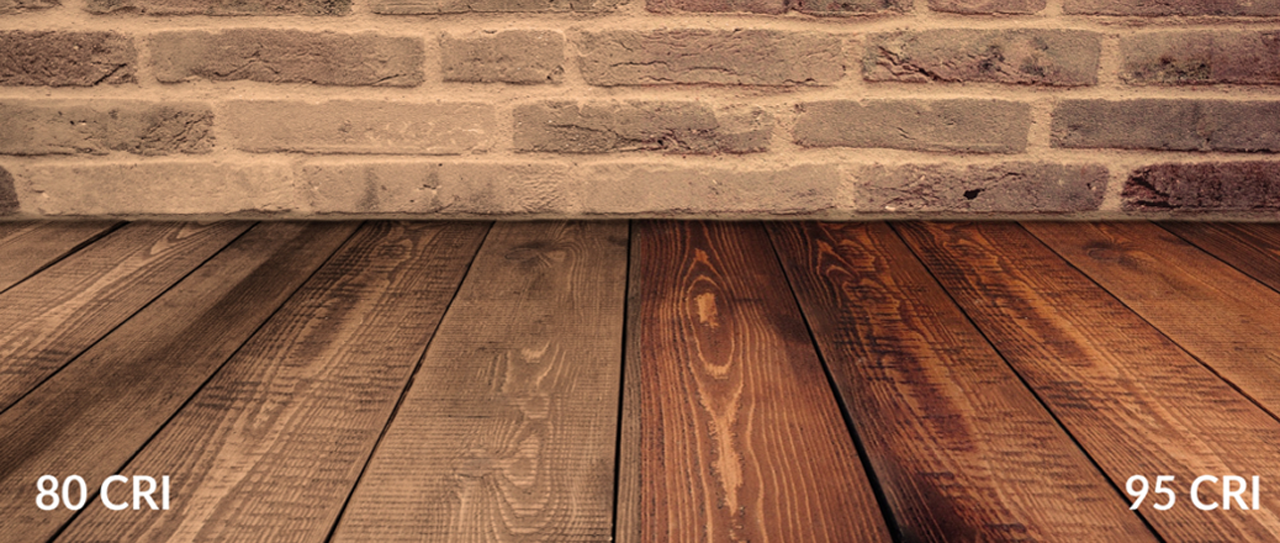
Color rendering is a difficult aspect of lighting, because it is not immediately visible the way color temperature is. So how do you know what the actual difference is between 80 CRI, 90 CRI, 95 CRI or higher, and whether it matters?
The ultimate answer is that it depends on your application, and how sensitive you or the occupants of the space are to light quality. Below, we'll go over some general criteria and applications for when it makes sense to use a certain level of CRI, and what differences you can expect between 80, 90 and 95 CRI.
Since you've found this article, we'll assume that you have a basic understanding of what color rendering is, and how it is measured. If not, we would recommend first reading several of our articles that explain what color rendering is.
80 CRI: Acceptable Color Quality
80 CRI is commonly seen as the baseline CRI level for LED and fluorescent lamps. It is definitely an acceptable level of color quality, where most obvious colors stand out and appear good enough for daily tasks. Most manufacturers have settled on 80 CRI as the standard or basic light quality offering, and you are likely to find that most lights sold at your local hardware store have a CRI value of 80.
With light sources that have an 80 CRI rating, you will likely find that nuanced colors, especially those that have a deep red component will appear unnatural. You may be surprised to learn that a lot of colors that don't appear immediately "red" will be affected due to their red component. Some examples include skin tones and wood furniture or flooring. If you like to host dinner parties, for example, your guests may leave with a slightly lowered impression of the visual and aesthetic aspects of the food or decor, even if at a subconscious level.

For a residential setting, 80 CRI is most appropriate for areas where you and your family spend the least amount of time in. Hallways, storage closets and garages are several examples of areas where 80 CRI may be sufficient. That being said, if you have a walk-in closet or a garage where you spend lots of time on your projects, you will likely want to use a higher CRI light source as color differentiation can be somewhat difficult.
On the other hand, we would recommend against 80 CRI light sources in kitchen areas, including under-cabinet lighting, as well as bathrooms. Food prep relies a lot on accurate color judgement (is the meat fully cooked?) and accurate lighting in bathrooms can be important when applying makeup.
Because higher CRI is almost always associated with lower efficiency, we certainly believe that 80 CRI is an appropriate color rendering level for certain applications where efficiency and cost are the primary objectives, but in general, we believe that 80 CRI is at best, an adequate level of color quality for the least demanding of circumstances.
Most 80 CRI light sources have an R9 value around 0 (more on R9 values below).
90 CRI: Good Color Quality
The difference between 80 and 90 CRI is very noticeable, and will immediately provide a nice boost in color clarity. For most residential installations, 90 CRI is a good fit for areas where you plan to spend the most time in: bedrooms, living rooms and the dining table.
Most objects, including fresh produce, meats, wood furniture and skin tones, for example, will for the most part appear normal, and you will not find anything to be off-putting or strange.
For residential installations, most will find that 90 CRI is sufficient for their needs, and those who are not as sensitive or picky about appearances will likely not see a noticeable improvement past 90 CRI.
Most 90 CRI light sources have an R9 value around 50.
95 CRI: Excellent / Professional Color Quality
Once we reach 95 CRI, color rendering reaches a new level of accuracy. For those whose profession or hobby relies on accurate color perception, the difference between 90 and 95 CRI is often an important and overlooked benefit. Visual artists, for example, will often find that the 95 CRI color accuracy is crucial for distinguishing subtle differences in hue or color tone in their work. In short, with the appropriate color temperature, objects under 95 CRI appear nearly identical to their appearance under natural light.
For residential applications, 95 CRI can bring additional benefits to the overall aesthetic. While the average person may be hard-pressed to identify between a 90 CRI and 95 CRI, subtle differences in color and appearances can help contribute to the cohesion of an interior space. For the average person, they may not even be aware that the lighting is what makes a space, but for interior designers, the 95 CRI is critical to ensure that their carefully chosen furniture and color schemes appear perfect.
Most 95 CRI light sources have an R9 value around 90.
Look At CRI R9
We have alluded to the R9 values for each of the 80, 90 and 95 CRI color quality levels. There is no set formula, but a very strong correlation between the CRI value and the R9 value, and they roughly correspond to 25, 50 and 90 for 80, 90 and 95 CRI, respectively.
While CRI is a general score that describes the accuracy of a light source, R9 is a specific score that looks at its ability to render red colors in particular. As we've mentioned above, red colors are some of the most prevalent in various objects and materials, and therefore using R9 as a supplement to CRI is a great way to evaluate a light source.
Perhaps some of the most noticeable differences between 50 and 90 R9 values are in skin tones. If you're at all involved in photography, for example, you will likely notice the difference immediately.
Final Thoughts
We've shared our thoughts from our experience and lighting expertise, and do hope that we were able to shed some light on the challenging topic of color rendering. At the end of the day, however, whether a certain level of color rendering is appropriate for a particular location depends on whether it ultimately has an effect on the people using the light or occupying the space. High CRI LED lighting does come at a higher purchase cost and lower efficiency, so these are also things to consider as downsides to improving the color rendering of a space.
Do you need information on HOLALUX products or services ?
